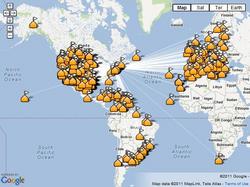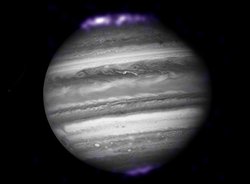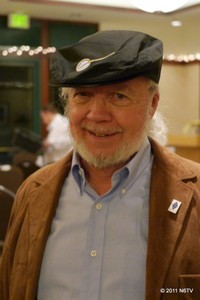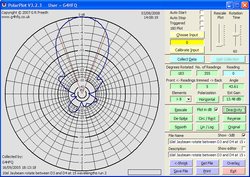 January 4, 2012 Editor: Ward Silver, NØAX | ||||||
IN THIS ISSUE
NEW HF OPERATORS - THINGS TO DO Have you tried RTTY contesting yet? If not, the ARRL RTTY Roundup is coming to town this weekend and will be a great opportunity to see how your station plays on the digital modes. Check out AA5AU's great website for tips on how to get started. Should you have a little spare time on Sunday, dial up the Kid's Day frequencies and put a smile on a young operator's face! BULLETINS There are no bulletins in this issue. BUSTED QSOS A relatively untarnished issue completed 2011 although K1QX points out that the French custom for wishing someone a happy New Year requires only "Bonne annee" - right back atcha, Craig! CONTEST SUMMARY Complete information for all contests follows the Conversation section 7-8 January
14-15 January
There is lots of Dayton Hamvention contesting news to report - the 6th annual Contest University (CTU) is now taking early-bird registrations through Jan 31. Held on May 17 at the Crowne Plaza in Dayton, Ohio, CTU offers the wit and wisdom of seasoned contest "professors" in a collegial all-day setting. New to the podium this year will be N6TR, K3NA, K7NV, XE1KK, W5WZ and K2RD along with familiar faces from years past. An additional incentive - if you have given (or will give by Dayton 2012) a talk about Amateur Radio Contesting to any club, hamfest or group since May 20, 2011 - you qualify for a $10.00 registration fee discount! Along with Contest University, the 20th Annual Dayton Contest Dinner is now taking ticket orders, as well. This is the venue at which the year's inductees to the CQ Contest Hall of Fame are announced. The Contest Dinner is held at the Dayton Crowne Plaza on Saturday night - May 19th this year - and always features a great keynote speakers and many prizes. While you're in Dayton, don't miss the Contest Super Suite held on FOUR straight nights (Wednesday - Saturday) in the Miami Ballroom of the Crowne Plaza. (Thanks, Tim K3LR)
David K2DSL has create a web application that reads an ADIF file generated from your logging program and creates a Google map of the contacts. You upload the ADIF file and the application displays a map in return. Each contact must include a latitude/longitude or grid square in order for it to show up. That information is available from QRZ.com or Hamcall. See the website and the FAQ for more information on this creative service. Working in parallel with David, Sebastian LW4HR has developed GeLog, an online tool for visualizing contacts on a Google map globe from an ADIF file. To use the tool, you'll need a QRZ.com data subscription for the lat/lon coordinates. Not only do the contacts appear on the globe, but so do the daylight and nighttime areas and the Sun zooms around the globe, too! Very nice work! An updated and edited version of the upcoming ARRL International DX Contest rules has been published and the ARRL is looking for volunteers to translate the rules into other languages. If you can help, please contact ARRL Contest Branch Manager, Sean KX9X. Time for a new calendar - how about this 2012 Old Tyme Radio Calendar from KB6NU's Ham Radio Blog? It's available for free downloading from WA1KPD's Boat Anchor Collection website. (Thanks, Jeff K1NSS) All your dots are belong to us! Here's a story about the first wireless hacker from the "That Didn't Take Long Department". Maybe some things never change! (Thanks, Doug K1DG) In case you were wondering, KG4 stations with two letters in their suffix are in Guantanamo Bay. KG4 stations with one or three letters in their suffix are in the continental United States. (Thanks, Daily DX) Bob N6TV has been busy programming, too, and has analyzed spots from the Reverse Beacon Network during the 2011 CQ Worldwide CW contest. Who were the most-spotted single-operators? And the most-spotted stations of any type?
They do everything big in...not Texas...Jupiter! Take a look at the Jovian auroras in this 2007 story from the NASA Science news. Consider the QRN implications! (Thanks, Glenn K6NA) Those of you who tried QRP in the recent Stew Perry Topband Distance Challenge will identify with Peter K3ZM's amusing mélange of Dickens and radiosport. (Thanks, Ralph N5RZ) In the last issue, the availability of the 73 Magazine issues online in the Internet Archive drew a lot of interest. Marty K1OYB pointed out that this was a voluntary contribution to the public domain by 73 magazine publisher, Wayne Green W2NSD who deserves a tip of the collective cap in this regard. Web Site of the Week - The latest issue of Contest Club Finland's PileUP! magazine was published online Dec 29, 2011, containing 68 pages of contest reporting. It includes numerous extended writeups on SAC 2011 from different viewpoints. Ever wonder what it is like to work SAC from JW5, OHØ, OH8, or K1, or what it is like to mobilize national troops for the Polar Battle or to organize an international contest? The Last Blast sheds light on SDR & RBN, and has the usual eccentric humor. (Thanks to the Pileup! editorial team - OH1WZ, OH2BH, OH6KZP, OH7WV) WORD TO THE WISE Confirmation - make SURE you get the expected confirming response from an email-handling robot after emailing your contest log. No response probably means that your log email bounced or was delayed or was sent to the rong address or...had something happen to it other than what you intended! A bounced email might also wind up in your "spam" or "junk mail" folder so don't assume that no news is good news. Oh, and read the robot's response, too - be sure the robot got your call right, the contest right, the category right, the number of contacts right, etc. (Thanks, Rich KL7RA) A new promotional video by the ARRL touting the Do It Yourself (DIY) nature of ham radio has been released to attract hackers, makers and innovators to the service. The video features well known hacker and maker Diana Eng KC2UHB along with Ham Nation's Bob Heil K9EID and ISS Astronaut Doug Wheelock KF5BOC. It's fast-paced and focuses on the innovative, imaginative and fun ways "hams" use radio technology in new and creative ways and points out that amateur radio clubs are similar to hacker groups. Materials to support the movie are available on the ARRL's Do It Yourself website. (Thanks, ARRL Media & Public Relations Manager, Allen W1AGP)
Those of you who enjoy Tim Allen in various sitcoms will want to be watching "Last Man Standing" on ABC on Tuesday nights. One aspect of Tim's character, Mike Baxter, is that of ham radio operator - he's been "assigned" the call sign KAØXTT and even has a Facebook page. The ham shack and occasional snippets of ham radio action are being worked into the story every week. This week's episode showed the station in the back of Mike's office. Browse to Mike's Facebook page and give it a "Like" for more radio action! Geoff WØCG/PJ2DX has updated the PJ2T website with a CQ Worldwide CW contest summary and photos. From the days before presentations featured "Here we are at the airport..." come these amazing pictures of the VQ3HGE expedition in the late 1940's featuring Bob W7LR. No switching power supplies here! (Thanks, Tim K3LR) Here's a useful, but very bad, example of literally interpreting grounding rules. (Thanks, Lynn N7CFO) Wow - keep those cards and letters coming in! Digging out from the log deluge, ARRL Contest Branch Manager, Sean KX9X reports, "As of January 3, we've received 5,102 logs for the 2011 ARRL 10 Meter Contest, including those on paper. This is unprecedented! We've shattered the 10 Meter Contest submission record by 2,200 logs and still have over a week to go before the submission deadline passes!" In addition, results for the December 2011 Rookie Roundup are available and certificates have been emailed to all Rookies thanks to the support of Bruce WA7BNM. Don AA5AU writes in to announce the results of the brand-new 2011 Ten-Meter RTTY Contest, less than a month after the contest! It looks like that new contest got off to a fast start! The DX results for the 2011 ARI DX International Contest are available at the ARI website or you can download a PDF version, if you prefer. UBN reports are being prepared and will be emailed to participants. Contest Manager, Bob I2WIJ, notes that there will be rule changes for the 2012 contest - a new start and end times and a shorter log submission deadline. OPERATING TIP Jeff K8ND has assembled a Topband operating aid for providing guidance in selecting operating frequencies on 160 meters. This is very handy, particularly to operators new to 160 meters. Jeff is in the process of updating the guide and if you have comments or corrections, please contact him as described in the publication. John G3JVC/GM3JVC recommends a useful publication for your bookshelf on fighting EMI developed by the US Naval Postgraduate School, "The Mitigation of Radio Noise From External Sources at Receiving Sites". It's a tour-de-force on problems hams know well. Speaking of locating noise sources, Phil WØXI has put an ultrasonic detector kit on the market that is quite useful for power-line noise. In addition, there are a couple of good construction articles by W1TRC in QST by Jim Hanson, W1TRC; "A Home-made Ultrasonic Arc Detector" in Apr 2006 and "Adapting a Three Element Tape Measure Beam For Power LIne Noise Hunting" in May 2007. (Thanks, Lee KØLW and Mike K4PI) Todd KF7SIS likes basic Rustoleum paint for protecting antennas against UV. To avoid overspray and waste, an inexpensive foam brush does a fine job with a can of flat black to apply two or three coats of paint. For those of you who like to build your own station accessories, check out K5LXP's version of the 6 x 2 coax switch. There is plenty of technical detail and some good reasons why these devices cost what they do! (Thanks, Brian N9ADG) It's very hard to see a butane flame outside and up on the tower when trying to solder. Mike K6BR takes along a small cardboard box with two sides cut out. It keeps the wind out while making it possible to see the flame. This avoids damage to the cable as well as to Mike!
Scott KBØFHP discovered a program called PolarPlot that can help map out an antenna radiation pattern fairly easily. "All you need is a constant RF source at the frequency desired, you rotate your beam, and the pattern is measured." What's the velocity factor (VF) of your coax? Would that be on the inside or the outside? VF is well-specified for RF inside the cable but the outside of the shield is completely different, electrically. That conducting surface acts like a fat, insulated wire with a VF around 95%! (Thanks, Steve G3TXQ) Although the half-sloper is a well-known antenna, it seems that everybody has a different way of installing them on the tower. Roger K8RI has developed what looks like a very robust method of getting the job done while keeping the coax-wire connections waterproof and secure. It starts with an aluminum bracket and SO-239 connector then waterproofs the assembly for tower-mounting. The Instructables web site recently posted a series of guides on basic electronics. These cover the fundamentals and might be useful for someone learning about ham radio or general electronics. Another neat Instructable shows how to "hack" a broadcast band radio for use in the great outdoors with a custom enclosure and offers some good ideas for portable operating and QRP rigs! These make great accompaniment to the new ARRL Do-It-Yourself video mentioned above. Technical Web Site of the Week - A common source of interference, particularly on 160 meters, is a mixing product from two or more AM broadcast stations. While it may sound like harmonics, "intermod" is not usually the fault of the broadcaster. If you suspect mixing you can use the Radio-Locator transmitter locating service by entering your location and looking for strong stations in your area. You can tell whether the products are being generated in your radio by switching in some attenuation. If you add 10 dB of attenuation and the products drop in strength by more than 10 dB, your receiver front end is likely being overloaded - try a broadcast-band reject filter (such as in the ARRL Handbook). Otherwise, the hunt outside is on! (Thanks, Doug K1DG) Measuring Up A couple of days ago my January-February issue of National Contest Journal showed up in the mail - the first issue under the editorship of Kirk K4RO. Kirk's first editorial struck a chord with me as he talked about ham radio and contesters being a good influence on him in his younger days. (No word on whether we're still a good influence!) That got me thinking. There are a lot of activities we encountered growing up but one aspect of ham radio that I found compelling - and still do - is that everyone has to play not only by man-made rules but by the natural rules of electronics and radio. You can't just bluster your way into the log. Either you make the contact or you don't.
Later in life during my days in product development I often encountered wishful thinking (sometimes my own) that somehow the circuits would just work or the code would just run without doing the dirty work or acquiring the necessary understanding. I'd say it was a safe assumption that was rarely a successful strategy and the same goes for ham radio. Contests are perhaps the sternest test ham radio has to offer. It is not enough to just talk a good game. When the starting bell sounds, you have to be on the air with enough skill and signal to get through and you have to persevere from beginning to end. The log checking report is an unblinking mirror to our operating in which excuses don't count. You can say the same for emergency communications, too, in that when the day is done either you got the message through or you didn't. By taking part in radiosport competitions, we can measure ourselves against any number of public standards - the Top Ten, the record tables, the plaque winners - and success counts for a lot because you do it yourself as a single-op or in a team. These are all very good things to learn when you're still trying to sort out how the world works and the earlier you learn those principles, the better. Measuring up is why ethics are so important in radiosport. What happens on the air is a matter of public record but it has to be backed up by personal behavior in the shack where nobody is watching - it's easy to be ethical in public. The meritocracy of radiosport is not often mentioned but it is a fundamental element of what makes it popular and stimulating - otherwise why would a Novice reading the contest results want so badly to be part of that community? If you're looking for a good New Year's resolution, helping to promote and maintain ethics on the air and in the shack would be an excellent use of one's time and energies. By maintaining high standards for "playing well with others" we also keep radio's Good Arrow pointed in the right direction. To the younger members of our communities, there is no better message we can send. 4 January to 17 January 2012 An expanded, downloadable version of QST's Contest Corral in PDF format is available. Check the sponsor's Web site for information on operating time restrictions and other instructions. HF CONTESTS ARRL RTTY Roundup--Digital, from Jan 7, 1800Z to Jan 8, 2400Z. Bands (MHz): 3.5-28. Exchange: RST, state/province/serial. Logs due: Feb 7. Rules Kid's Day--Phone, from Jan 8, 1800Z to Jan 8, 2400Z. Bands (MHz): 3.5-28. Exchange: Name, age, location, favorite color. Rules North American QSO Party--CW, from Jan 14, 1800Z to Jan 15, 0600Z. Bands (MHz): 1.8-28. Exchange: Name and S/P/C. Logs due: 14 days. Rules 070 PSKFest--Digital, from Jan 7, 0000Z to Jan 7, 2400Z. Bands (MHz): 3.5-28. Exchange: Call sign, RST, S/P/C . Logs due: Jan 21. Rules CWops Weekend Mini-CWT Test--CW, from Jan 7, 1300Z - multiple operating periods. Bands (MHz): 1.8-28. Frequencies: 18 to 28 kHz above band edge. Exchange: Name and member number or S/P/C. Logs due: 2 days. Rules Original QRP Contest--CW, from Jan 7, 1500Z to Jan 8, 1500Z. Bands (MHz): 3.5-14. Exchange: RST, serial, and category. Logs due: Jan 31. Rules DARC 10 Meter Contest--Phone,CW, from Jan 8, 0900Z to Jan 8, 1059Z. Bands (MHz): 28. Exchange: RS(T), serial, DOK code. Logs due: 3 weeks. Rules Midwinter QSO Party--Phone,CW, from Jan 8, 1000Z to Jan 8, 1400Z. Bands (MHz): 3.5-28. Exchange: RS(T) and serial. Logs due: Feb 15. Rules ARS Spartan Sprint--CW, from Jan 10, 0200Z to Jan 10, 0400Z. Bands (MHz): 3.5-28. Exchange: RST, S/P/C, and power. Logs due: 2 days. Rules CWops Monthly Mini-CWT Test--CW, from Jan 11, 1300Z - multiple operating periods. Bands (MHz): 1.8-28. Frequencies: 18 to 28 kHz above band edge. Exchange: Name and member number or S/P/C. Logs due: 2 days. Rules SNS and NS Weekly Sprints--CW, from Jan 13, 0200Z to Jan 13, 0300Z. Bands (MHz): 1.8-14. Exchange: Serial, name, and S/P/C. Logs due: 2 days. Rules Hunting Lions In the Air--Phone,CW,Digital, from Jan 14, 0000Z to Jan 15, 2359Z. Bands (MHz): 1.8-28. Exchange: RS(T), serial or name, club name, district. Logs due: Feb 28. Rules MI QRP Club Jan QRP Contest--CW, from Jan 14, 1200Z to Jan 15, 2359Z. Bands (MHz): 1.8-28, 50. Exchange: RST, S/P/C, MI QRP number or power. Logs due: Feb 10. Rules WW Peace Messenger Cities--Phone,CW, from Jan 14, 1200Z to Jan 15, 1200Z. Bands (MHz): 3.5-28. Exchange: RS(T) and PMC ref number or CQ zone. Logs due: 30 days. Rules EUCW 160 Meter Contest--CW, from Jan 14, 2000Z - multiple operating periods. Bands (MHz): 1.8. Exchange: RST, serial, club name, member nr or "NR". Logs due: Feb 15. Rules VHF+ CONTESTS MI QRP Club Jan QRP Contest--CW, from Jan 14, 1200Z to Jan 15, 2359Z. Bands (MHz): 1.8-28, 50. Exchange: RST, S/P/C, MI QRP number or power. Logs due: Feb 10. Rules LOG DUE DATES 4 January to 17 January 2012
ARRL Information Click here to advertise in this newsletter. Your One-Stop Resource for Amateur Radio News and Information ARRL membership includes QST, Amateur Radio's most popular and informative journal, delivered to your mailbox each month. Subscribe to NCJ - the National Contest Journal. Published bimonthly, features articles by top contesters, letters, hints, statistics, scores, NA Sprint and QSO Parties. Subscribe to QEX - A Forum for Communications Experimenters. Published bimonthly, features technical articles, construction projects, columns and other items of interest to radio amateurs and communications professionals. Free of charge to ARRL members: Subscribe to The ARRL Letter (weekly digest of news and information), the ARES E-Letter (monthly public service and emergency communications news), Division and Section news -- and much more! ARRL offers a wide array of products to enhance your enjoyment of Amateur Radio. Visit the site often for new publications, specials and sales. Donate to the fund of your choice -- support programs not funded by member dues! Reprint permission can be obtained by sending email to permission@arrl.org with a description of the material and the reprint publication. ACKNOWLEDGEMENTS ARRL Contest Update wishes to acknowledge information from WA7BNM's Contest Calendar and SM3CER's Contest Calendar. | ||||||











